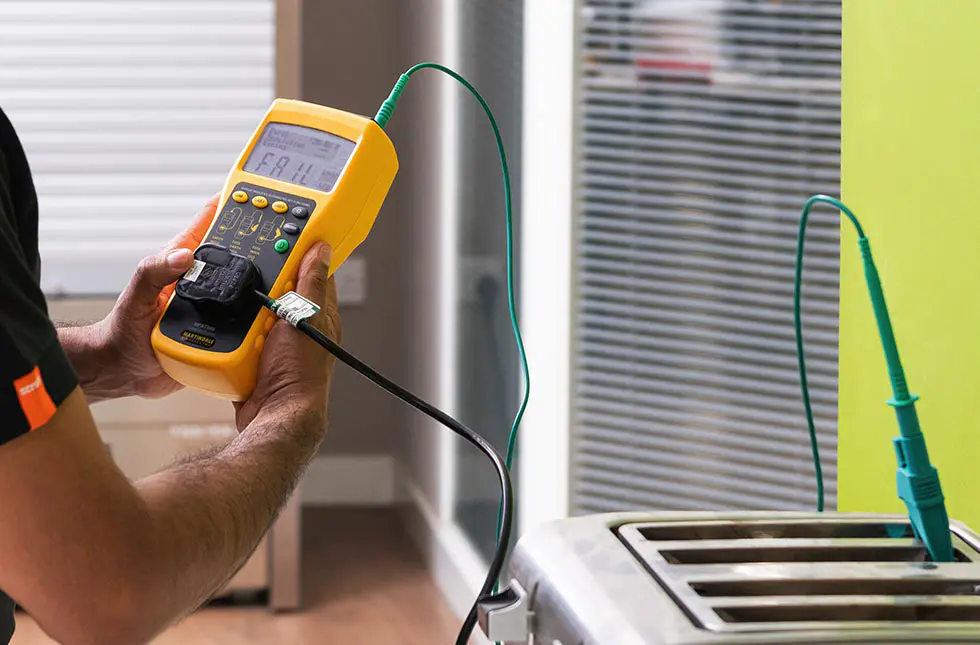Have you ever considered the hidden dangers that lurk within the electrical appliances in your business premises?
The importance of PAT testing goes beyond mere compliance; it is a critical step in safeguarding your employees, customers, and business assets.
By understanding the key benefits and requirements of PAT testing, you can mitigate risks, ensure regulatory adherence, and protect your business from potential disasters.
Let’s explore how prioritizing PAT testing can not only save you money and time but also establish a secure environment for all stakeholders involved.
Understanding PAT Testing
Understanding PAT Testing involves meticulous inspection of electrical appliances to ensure safety standards are met and potential hazards are identified promptly. The process plays a vital role in risk management by preventing accidents through regular equipment testing.

By adhering to regulations, businesses prioritize workplace safety and maintain compliance with standards. The benefits of PAT Testing extend beyond mere safety; it also aids in efficient electrical maintenance, safeguarding against costly damages and legal liabilities.
Through rigorous examination of appliances, this practice ensures that all equipment meets the necessary safety regulations, creating a secure working environment. By conducting PAT Testing at regular intervals, businesses can effectively mitigate risks associated with electrical failures, thus protecting both employees and property.
Ultimately, investing in PAT Testing not only promotes safety but also demonstrates a commitment to upholding the highest safety standards, safeguarding businesses against potential hazards and ensuring operational continuity.
Choosing a PAT Testing Company
When selecting a PAT Testing company, it is essential to thoroughly assess the company’s credentials and reputation to ensure compliance with safety standards. Company selection should be based on various factors including pricing, reputation, equipment, certification, experience, customer service, reliability, efficiency, and scheduling. Below is a detailed table to guide you in making an informed decision:
| Factors | Description |
|---|---|
| Pricing | Ensure competitive rates without compromising on quality and compliance |
| Reputation | Check reviews and testimonials to gauge the company’s standing in the industry |
| Equipment | Confirm that the company uses modern and calibrated testing equipment |
| Certification | Verify the technicians’ certifications and the company’s accreditation |
| Experience | Prioritize companies with a proven track record and extensive experience |
Steps in PAT Testing
In conducting PAT Testing, the initial step involves performing a visual inspection of the appliances to assess their condition and safety. This inspection includes checking for any exposed metal parts and examining the overall cable condition for any signs of wear or damage.
Following the visual assessment, insulation testing is conducted to ensure the integrity of the appliance’s insulation, which is crucial for preventing electrical faults. Additionally, grounding verification is carried out to confirm that the appliance is properly grounded, reducing the risk of electric shocks.
The Necessity of Regular Testing
Regular testing of electrical appliances is essential to ensure ongoing safety and compliance within a business environment. Safety assurance is paramount when it comes to the operation of electrical equipment. By conducting regular testing, the risk of potential accidents and hazards is significantly reduced, thus preventing harm to employees and customers.

Additionally, through consistent testing, equipment maintenance is upheld, ensuring that appliances are in optimal working condition and free from defects that could compromise safety. Workplace compliance is another crucial aspect that regular testing addresses, as it ensures that businesses adhere to legal regulations and industry standards.
Compliance and Insurance Aspects
Moving from the aspect of regular testing to compliance and insurance considerations, businesses must adhere to specific regulations and insurance policies regarding the safety of electrical appliances within their premises. Ensuring regulatory compliance and meeting insurance requirements is essential for legal protection, business continuity, and overall safety. By conducting PAT testing regularly, businesses demonstrate their commitment to safety, which can help avoid invalidated insurance policies and protect against legal consequences. Compliance with safety standards not only fosters a safe working environment but also mitigates risks associated with electrical appliances. Below is a table summarizing the key aspects of compliance and insurance requirements:
| Aspect | Importance | Impact |
|---|---|---|
| Insurance Policies | Ensures coverage in case of incidents | Protects financial interests |
| Regulatory Compliance | Demonstrates adherence to laws | Avoids penalties |
| Safety Standards | Upholds workplace safety | Prevents accidents |
Financial Benefits of PAT Testing
An essential aspect to consider in the realm of PAT testing is the financial benefits it offers to businesses. PAT testing contributes to significant cost savings by identifying faulty appliances early on, preventing extensive damage, and avoiding electrical fires.

This proactive approach helps in minimizing potential downtime, thus reducing the need for costly repairs and replacements. By ensuring regular equipment maintenance through PAT testing, businesses can protect their financial interests by mitigating risks, enhancing safety assurance, and providing long-term financial protection.
Additionally, the financial benefits extend to preventing costly damages and legal liabilities, ultimately creating a secure working environment. Therefore, investing in PAT testing not only aligns with compliance and insurance requirements but also serves as a strategic financial decision that safeguards the business from unforeseen financial burdens while promoting a culture of safety and reliability.
Frequently Asked Questions
What Are Some Common Misconceptions About PAT Testing That Businesses Should Be Aware Of?
I believe common misconceptions about PAT testing include the importance being overlooked, costly mistakes from DIY attempts, and compliance confusion. Businesses should prioritize professional testing to ensure safety, avoid risks, and maintain compliance.
How Does the Frequency of PAT Testing Differ for Different Types of Industries or Businesses?
The frequency of PAT testing varies across industries due to unique safety needs and regulatory standards. Adherence to industry-specific guidelines, advancements in testing technology, regular employee training, and compliance ensure optimal electrical safety protocols are maintained.
Are There Any Specific Regulations or Guidelines That Businesses Need to Follow When Conducting PAT Testing?
Regulations and compliance are paramount in PAT testing. Safety standards must be upheld through regular inspections. Proper equipment, training, and certification are essential. Documentation and record-keeping ensure adherence to guidelines, fostering a secure environment.
What Are Some Emerging Trends or Advancements in PAT Testing Technology That Businesses Should Be Aware Of?
As a business owner, staying updated on technology advancements, industry trends, and testing innovations in PAT testing is vital. Regularly upgrading equipment, keeping up with training requirements, and embracing new testing techniques ensure safety compliance.
How Can Businesses Ensure That Their Employees Are Properly Trained to Conduct PAT Testing In-House, if Needed?
To ensure employees are trained for in-house PAT testing, I prioritize thorough training programs covering equipment maintenance, safety compliance, and risk assessment. If needed, outsourced services can supplement to guarantee comprehensive and accurate testing procedures.
Conclusion
In conclusion, implementing regular PAT testing in my business is essential to ensure the safety of my employees and customers. By proactively identifying and addressing electrical defects, I can prevent accidents, comply with regulations, and save money in the long run.
Choosing a reputable PAT testing company, following the necessary steps, and staying compliant with insurance requirements are key aspects of maintaining a secure working environment and protecting my business from potential risks.





